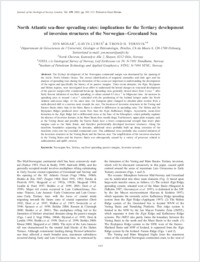North Atlantic sea-floor spreading rates: implications for the Tertiary development of inversion structures of the Norwegian–Greenland Sea
- Mosar, Jon Department of Geosciences, University of Fribourg, Switzerland
- Lewis, Gavin Norsk Chevron, Oslo, Norway
- Torsvik, Trond H. VISTA, c/o Geological Survey of Norway, Trondheim, Norway - Institute of Petroleum Technology and Applied Geophysics, Norway
-
2002
Published in:
- Journal of the Geological Society. - 2002, vol. 159, no. 5, p. 503-515
English
Tertiary development of the Norwegian continental margin was dominated by the opening of the Arctic–North Atlantic Ocean. The correct identification of magnetic anomalies and their ages and the analysis of spreading rates during the formation of this ocean are important in understanding the development of the region and specifically the history of its passive margins. Three ocean domains, the Ægir, Reykjanes and Mohns regions, were investigated in an effort to understand the lateral changes in structural development of the passive margin after continental break-up. Spreading rates generally slowed down from 2 cm a⁻¹ after Early Eocene initiation of sea-floor spreading, to values around 0.5 cm a⁻¹ in Oligocene time. An increase in spreading rates to around 1 cm a⁻¹ coincided with the positioning of the Iceland hotspot under the North Atlantic mid-ocean ridge. At the same time, the European plate changed its absolute plate motion from a north-directed drift to a motion more towards the east. The location of inversion structures in the Vøring and Faeroes Basin rather than in the Møre Basin is related to differences in spreading rates. The Mohns and the Reykjanes Ridges produced more ocean floor than the Ægir–Kolbeinsey Ridges. Asymmetric ocean-floor formation in the Ægir Ridge led to differential stress at the base of the lithosphere, which probably explains the absence of inversion features in the Møre Basin (less mantle drag). Furthermore, upper plate margins such as the Vøring Basin and possibly the Faeroe Basin have a lower compressional strength than lower plate margins such as the Møre Basin, and therefore preferentially developed inversion structures. Along the transform boundaries separating the domains, additional stress probably built up along extension of the transform zones into the extended continental crust. This additional stress probably also assisted initiation of the inversion structures in the Vøring Basin and the Faeroes area. The amplification of the inversion structures in the Vøring Basin and the Faeroes Basin was subsequently caused by a variety of processes related to sedimentation and uplift–erosion.
- Faculty
- Faculté des sciences et de médecine
- Department
- Département de Géosciences
- Language
-
- English
- Classification
- Geology
- License
-
License undefined
- Identifiers
-
- RERO DOC 4928
- DOI 10.1144/0016-764901-135
- Persistent URL
- https://folia.unifr.ch/unifr/documents/299580
Statistics
Document views: 152
File downloads:
- Texte intégral: 396
